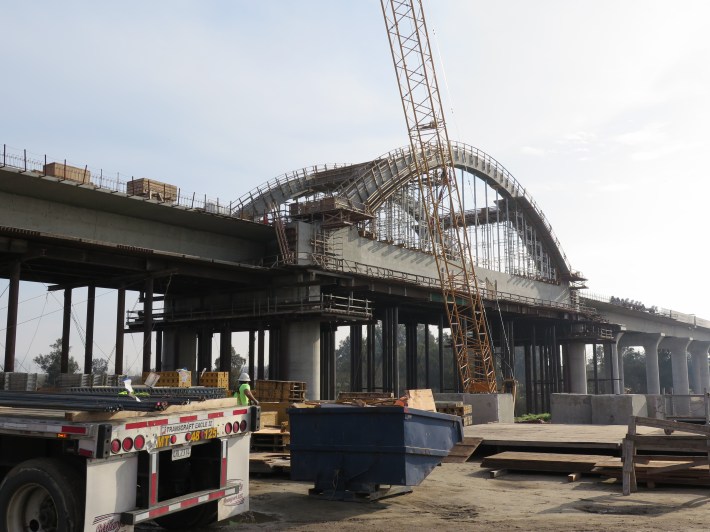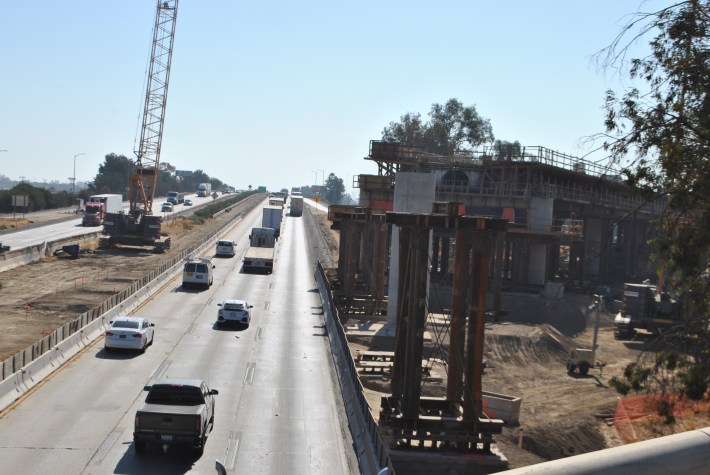California High-Speed Rail is under construction. It is. Central Valley construction contracts total nearly $4 billion. There are 30 active construction sites spanning 119 miles across five counties: Madera, Fresno, Kings, Tulare and Kern.
Under the current business plan high-speed rail operations are anticipated to start in 2027 on 171 miles of high-speed rail.
According to California High-Speed Rail Authority (CAHSRA) spokesperson Annie Parker, high-speed rail "is currently the biggest infrastructure project in California, and one of the biggest, if not the biggest in the U.S."
The construction is hard to miss for people driving through California's Central Valley, especially on Highway 99 through Fresno. Many folks living in Southern and Northern California seem unaware construction is underway. That might be because the L.A. Times, with its shameful record of misleading reporting on CAHSR, gives the impression that almost nothing is happening. Other mainstream media haven't done much better.
For some sense of the magnitude of the project, watch CAHSRA's 2019 Year in Review video.
There are four design-build "construction packages" currently in progress across the Central Valley:
- Construction Package 1 - $1.8 billion - started in 2013 - 32 miles between Avenue 19 in Madera County to East American Avenue in Fresno County. The package includes 12 grade separations, two viaducts, one tunnel, and a major river crossing over the San Joaquin River.
- Construction Packages 2-3 - $1.6 billion - started in 2015 - approximately 60 miles from East American Avenue in Fresno to one mile north of the Tulare-Kern County line. The package includes approximately 36 grade separations in the counties of Fresno, Tulare and Kings, including viaducts, underpasses and overpasses.
- Construction Package 4 - $509 million - started in 2016 - 22 miles from one mile north of the Tulare/Kern County Line to Poplar Avenue at the edge of the city of Shafter. The package include construction of at-grade, retained fill, and aerial sections of high-speed rail and the relocation of four miles of existing Burlington Northern Santa Fe (BNSF) tracks.
(In addition to this spending, CAHSRA is also funding rail improvements outside the Central Valley, via various Proposition 1A Connectivity and Early Investment Funds. These projects include grade separation projects to improve current rail operations and to prepare for HSR - for example, the L.A. County Metro Rosecrans/Marquardt Grade Separation Project. CAHSRA is also contributing to the electrification of Caltrain in the Bay Area.)
Among the most visible projects in the Central Valley are two massive viaducts which will serve as gateways to the city of Fresno:

San Joaquin River Viaduct - Located in north Fresno, the San Joaquin River Viaduct is a 4,700-foot span over the San Joaquin River parallel to State Route 99. Its arches represent the northern gateway into Fresno. A pergola structure will allow high-speed trains to cross over the top of the Union Pacific tracks. The project is expected to be completed in late 2020.

Cedar Viaduct - Located in south Fresno, the Cedar Viaduct is 3,700-feet long, spanning Highway 99 and North and Cedar Avenues. The viaduct and its concrete arches will be completed in late 2020.
This large infrastructure project has not gone unnoticed by people who live and work in the Central Valley. It has contributed significantly to improving the Central Valley economy - which generally has lagged behind other parts of California. As intended, construction jobs are improving the lives of Central Valley residents.
According to the CAHSRA, current construction has already created more than 3,500 jobs in the Central Valley. Thirty percent of all project work hours have been performed by workers living in economically distressed areas. Per CAHSRA, "The direct impact of the Authority’s investment between July 2017 and June 2018 is equivalent to about 18 percent of the 14,000 jobs that the Central Valley economy added over the same period. In Fresno County, the overall investment is equivalent to roughly 50 percent of the total jobs added during this time period, with direct jobs representing about 30 percent of the total. [...] In recent years, the Central Valley economy has lagged behind the rest of the state, but now investment in high-speed rail is helping to close the gap."
Despite a dearth of attention in many parts of the state, California High-Speed Rail construction continues apace. The rail construction is already having important immediate economic benefits for parts of the state where it is very much needed. Once in operation, high-speed rail will have huge mobility and environmental benefits for all Californians.






